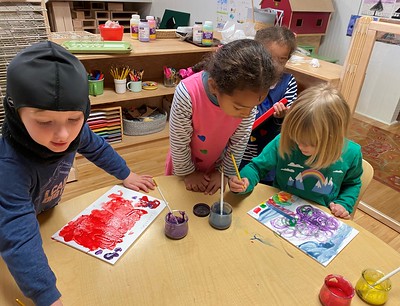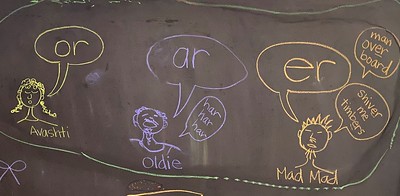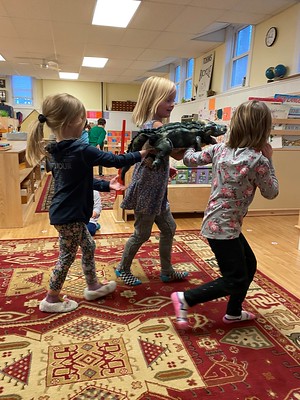The Monday students created egg tempera paint by cracking open an egg, separating the yolks from the whites, and mixing some powdered color into the yolk. They then used their egg tempera paint to create beautiful, luminous paintings. Egg tempera paints were used in Medieval and Renaissance paintings as they are long lasting, semi-transparent, and use less pigment.
During sign language we reviewed the bird signs, numbers to 10, the alphabet, and some emotions signs we learned last week. Rose then read and signed a story about some turkeys sitting in a tree, watching as all the other woodland animals were hard at work.
Pete Seeger’s version of Stone Soup was introduced, including the stone soup song, “Stone soup is what you need, when you have some friends to feed, step right up with what you’ve got, add it all to the big soup pot!” We introduced perspective taking by discussing how the soldier might have been feeling and what he might have been thinking, and what the villagers may have been thinking and feeling. The students were introduced to thinking and talking bubbles. We all have thoughts and feelings, and others may be able to read our body language and facial expressions to interpret some of this, but we can only know the thoughts in someone’s head if they speak them out loud and tell us what they are thinking and feeling. We did a little experimenting. The children took turns telling Lyn what they were feeling/thinking, and she wrote it down on the bubble. The child would hold the thinking bubble up and call on two students to guess what he/she was thinking and feeling. The talking bubble would then be held up with the words the child shared, and they would then say out loud what was written on the talking bubble, telling everyone what they were thinking and feeling.
Kindergarten students met three pirates. Some pirates say “ar,” some say “er,” and some say “or!” The students drew their own pirate ships with pirates who say “ar,” “er,” and “or.” Some students began brainstorming lists of words and phrases that have er, ar, or or in them, such as car, far, bar, jar, & star, “Shiver me timbers!” and “Har, har, har!”
We have moved on from our study of birds to an exploration of reptiles. The children had fun with reptile puppets and figures, including snakes, turtles, tortoises, lizards, and crocodilians. On Friday we read the book All About Reptiles, which taught us that reptiles have dry, scaly skin, are cold blooded so need outside sources to warm their bodies (unlike us, who as mammals are warm blooded, meaning our bodies create our own heat), and most of them lay eggs from which their babies hatch. We learned that many reptiles have defense mechanisms to protect themselves and recorded a list of some of these characteristics that are used to help keep them safe, such as armor (turtle shell), venom, hissing, shooting blood from their eyes, and camouflage. The children then selected three areas in the classroom and identified the color and pattern of that area where a reptile could hide, then colored three reptiles to match where they would hide. The children then hid their reptiles and went on a hunt to see if they could find all the camouflaged animals.






























































